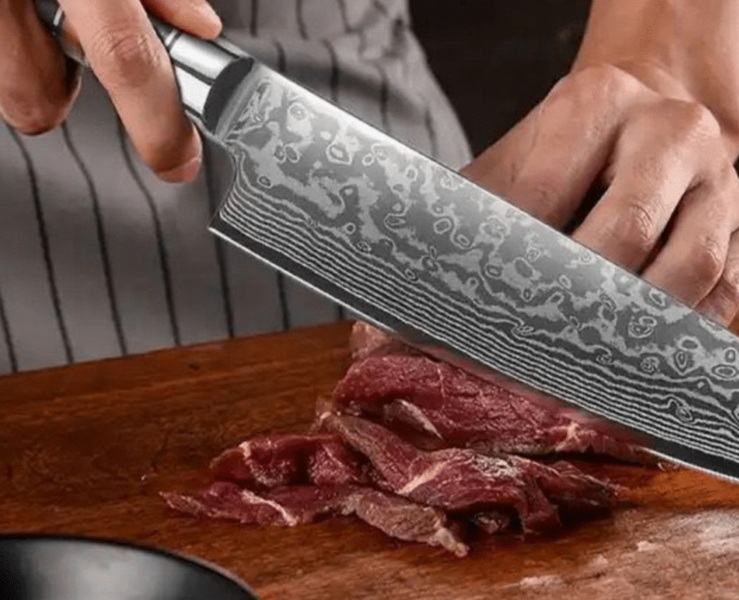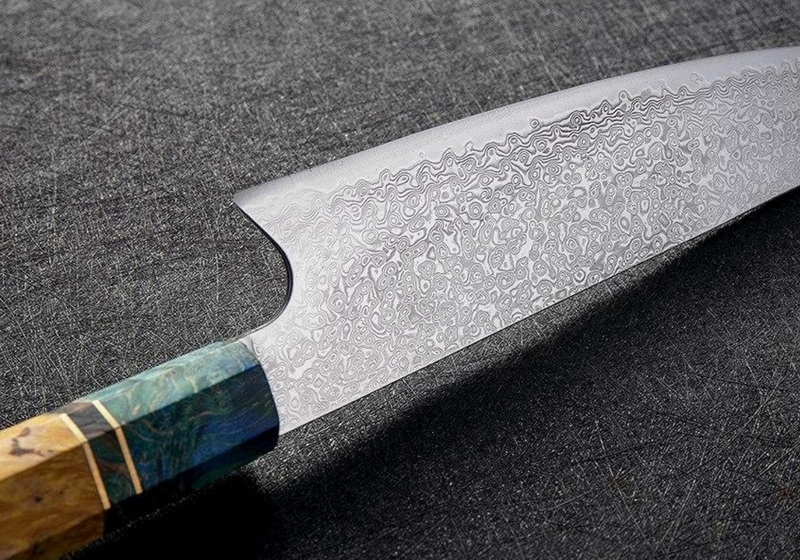- All
- Product Name
- Product Keyword
- Product Model
- Product Summary
- Product Description
- Multi Field Search
Views: 222 Author: Ann Publish Time: 2025-10-17 Origin: Site











Content Menu
● Understanding Damascus Knives
● Blade Sharpness and Edge Retention
● Authenticity and Pattern Quality
● Blade Construction Methods and Steel Type
● Handle Material and Ergonomics
● Knife Types and Intended Use
● Budget and Warranty Considerations
● Purchasing Tips for Online Buyers
● FAQ
>> Q1: How can I verify a Damascus knife is authentic when buying online?
>> Q2: What steel types are best for Damascus knives?
>> Q3: How do I maintain the sharpness and appearance of a Damascus knife?
>> Q4: Which Damascus knife style suits professional chefs?
>> Q5: Can Damascus knives be customized via OEM services?
Damascus knives capture the admiration of knife enthusiasts worldwide with their elegant, flowing patterns and exceptional performance. For anyone considering purchasing a Damascus knife online, understanding the key factors that separate genuine, high-quality knives from mere decorative items is essential. An informed choice ensures you invest in a durable, sharp, and comfortable tool that enhances your culinary or outdoor experience.

At its core, a Damascus knife is recognized by its distinctive layered steel pattern. This design originates from a forging method that combines two or more steels, producing a blade that blends the best characteristics of each metal: hardness, flexibility, corrosion resistance, and aesthetic appeal. Contemporary Damascus knives typically employ high-quality steels such as VG-10, 1095 carbon steel, or a combination with 15N20 nickel steel, either by clad (San-Mai) construction or full pattern-welded layering that extends throughout the blade.
One hallmark of Damascus knives is their remarkable sharpness, often surpassing standard kitchen knives. Thanks to the high-carbon layers, Damascus blades maintain a razor-sharp edge for extended periods, reducing the need for frequent sharpening. The Rockwell hardness (HRC) is a useful specification to check; a well-heat-treated Damascus blade typically ranges between HRC 58 to 62, striking a balance between sharpness and brittleness.
Since the beauty of Damascus steel is a major draw, it's essential to distinguish authentic Damascus blades from imitations. Genuine Damascus knives exhibit multi-layered steel visible on the blade's surface, including the spine and edge areas, with intricate wave-like or flowing patterns. Fake or low-quality knives often rely on laser etching or surface treatments that only mimic this look superficially. Close examination of product photos, preferably from trusted sources, is crucial.
Damascus blades are generally crafted in two ways:
- Clad or San-Mai Construction: This features a solid, high-performance steel core enveloped by patterned steel layers. The core performs the cutting duty, while the Damascus layers add aesthetic appeal and toughness. VG-10 is a popular core steel due to its wear resistance, sharpness, and corrosion resistance.
- Full Pattern-Welded Blade: Here, multiple layers of steels like 1095 carbon and 15N20 nickel are forge-welded entirely through the blade. The nickel layers impart a bright contrast and add toughness. This technique produces striking patterns that extend to the cutting edge and overall blade structure.
Choosing the right steel type depends on your usage. For kitchen tasks, corrosion resistance and edge sharpness are vital. For hunting or outdoor knives, toughness and impact resistance are priorities.
A Damascus knife's handle is as important as its blade. The material affects grip, durability, maintenance, and overall aesthetics. Common handle materials include:
- Wood (e.g., rosewood or pakkawood): Offers a classic look and comfortable grip but may require more care to avoid moisture damage.
- Micarta and G10: Synthetic, durable, water-resistant materials favored for modern ergonomic designs.
- Resin or composite materials: Often paired with intricate designs to complement the blade's beauty.
Ergonomics matter for prolonged use: a balanced weight distribution, smooth finish without sharp edges, and a handle shape that fits securely in your hand reduce fatigue and enhance control.
Damascus knives come in various forms, each suited for different tasks:
- Chef's Knife (8-10 inches): Ideal for versatile kitchen jobs, such as chopping, slicing, and dicing.
- Santoku Knife (around 7 inches): Good for slicing, dicing, and mincing with an emphasis on precision.
- Paring Knife (small, 3-4 inches): Best for delicate tasks like peeling and garnishing.
- Cleavers and Butcher Knives: Heavier knives suitable for cutting through bones and tough meat.
- Pocket or Folding Knives: Compact Damascus options for everyday carry (EDC), camping, or hiking, blending aesthetics with utility.
Choosing a style that matches your cooking or outdoor needs maximizes your enjoyment and efficiency.

To preserve the beauty and performance of a Damascus knife, follow careful maintenance:
- Hand wash with warm water and mild soap, avoiding harsh detergents or dishwashers.
- Thoroughly dry after washing to prevent rust or water spots.
- Regularly hone the blade to maintain sharpness.
- Sharpen using whetstones or professional services when needed.
- Store safely, ideally in a knife block or sheath, to protect edges and prevent accidents.
Damascus knives range broadly in price, reflecting differences in craftsmanship, steel quality, and brand reputation. Handmade or limited-edition knives can carry premium price tags, while mass-produced options are more affordable. Beware of unusually low prices for “authentic” Damascus knives, as these may be fakes or poorly made. Many reputable manufacturers provide warranties and customer support, giving peace of mind with your purchase.
- Read detailed product descriptions thoroughly to verify steel composition, manufacturing process, handle materials, and blade dimensions.
- Inspect multiple high-resolution images focusing on blade patterns, handle details, and finishing quality.
- Look for video demonstrations showing cutting performance and handling.
- Review customer feedback for insights on durability and satisfaction.
- Choose OEM suppliers or sellers known for quality Damascus knife production and service.
A Damascus knife is more than a kitchen or utility tool—it's a lasting investment in quality, elegance, and functionality. By considering steel type, blade construction, sharpness, authenticity, handle comfort, and your specific use case, you ensure your Damascus knife purchase delivers superb performance and beauty for years to come.

A1: Genuine Damascus knives display multi-layered patterns visible on all blade surfaces, not just surface etching. Examine detailed photos, check steel composition, and purchase from trusted OEM manufacturers or reputable sellers.
A2: Popular steels include VG-10 for corrosion resistance and sharpness, and a combination of 1095 high-carbon steel with 15N20 nickel steel for toughness and striking contrast.
A3: Hand wash and dry the knife promptly, hone regularly, sharpen as needed, and store properly to prevent rust and damage.
A4: Chef's knives with VG-10 core and thin, hard blades (HRC 60+) are preferred for slicing precision and durability in professional kitchens.
A5: Yes, many manufacturers offer OEM customization for blade steel, handle designs, packaging, and branding tailored to client needs.
The Ultimate Professional Knives for Halal Butchery in Middle Eastern Kitchens
Chef Knife Size Guide: Choosing Between 6″, 8″, 10″, And 12″
Custom Knife Handles: How To Design A Chef Knife That Fits Your Hand Perfectly
Chef Knife Surface Treatments Guide: From Polished Migaki To Damascus Patterns
Inside Our Professional Knife Sample Room: Quality You Can See
Universal Knife Block Buying Guide: Modern Acrylic & ABS Knife Holders for Professional Kitchens
Universal Knife Block: The Complete Guide To Modern, Hygienic Knife Storage
The Complete Guide To Red Handle Knife Sets: Style Meets Functionality in The Kitchen
Professional Knives for Halal Butchery And Middle Eastern Cuisine